Ever looked at a piece of wooden furniture and wondered how those elegant grooves were carved? What if I told you it’s possible to do it by hand, with the right tools and techniques? Intrigued? Let’s dive in!
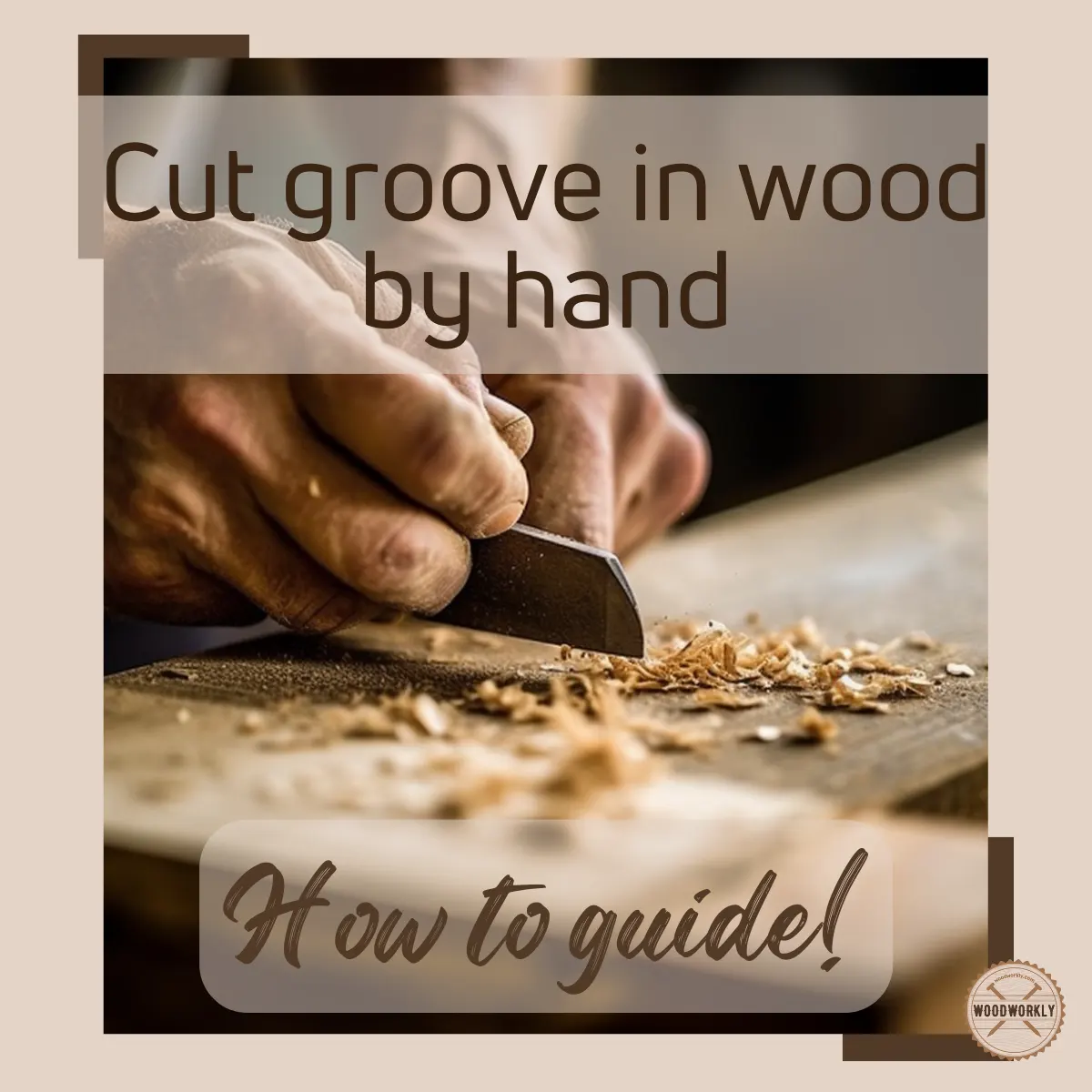
Grooves are useful for guiding movable parts in your woodworking projects. Generally, grooves are made using power tools.
But you might wonder “Why go through the effort of doing this by hand when there are power tools available?” it’s a good question.
Generally, power tools indeed make the job faster, but hand tools offer excellent precision and control that is unmatched.
That’s why I thought to share with you the best technique that I have used for many years when cutting grooves with my hand as a seasoned woodworker.
You can be a master craftsman by creating remarkable works of art and function with simple hand tools.
So, let’s find out, How to cut a groove in wood by hand?
To cut a groove in wood by hand, first, select the right type and size of the chisel. Then, determine the groove size and mark the groove. Next, cut the sides of the groove with a backsaw and remove the wood within the groove with a chisel avoiding tear-out.
But that’s just the tip of the iceberg!

So, in this article, I’ll explore how to cut a groove in wood by hand with a step-by-step procedure with all the tips and chisel techniques.
Furthermore, I’ll answer some frequently asked questions as well.
Let’s jump in!

Can You Cut a Groove in Wood by Hand?
Yes, absolutely! You can cut a groove in wood by hand without any issue.
Cutting grooves by hand is an ancient technique that was used before the advent of power tools like routers and table saws.
By cutting grooves by hand, you’re not just making a piece of furniture or wooden object; you’re participating in a time-honored tradition.
Hand tools give good precision and control than using power tools to cut grooves.
When a groove in wood by hand, you can feel the grain of the wood and adjust the technique as needed, and most importantly take pride in the fact that every single cut is a result of your skill and dedication.
Hand-cut grooves are great for traditional furniture and woodwork such as frame and panel constructions.
For example, when you’re making a cabinet door or traditional wooden chest, hand-cut grooves are great for holding planes in one place.
These grooves won’t be visible once the pieces are assembled, but their precision impact the quality and the durability of the project.
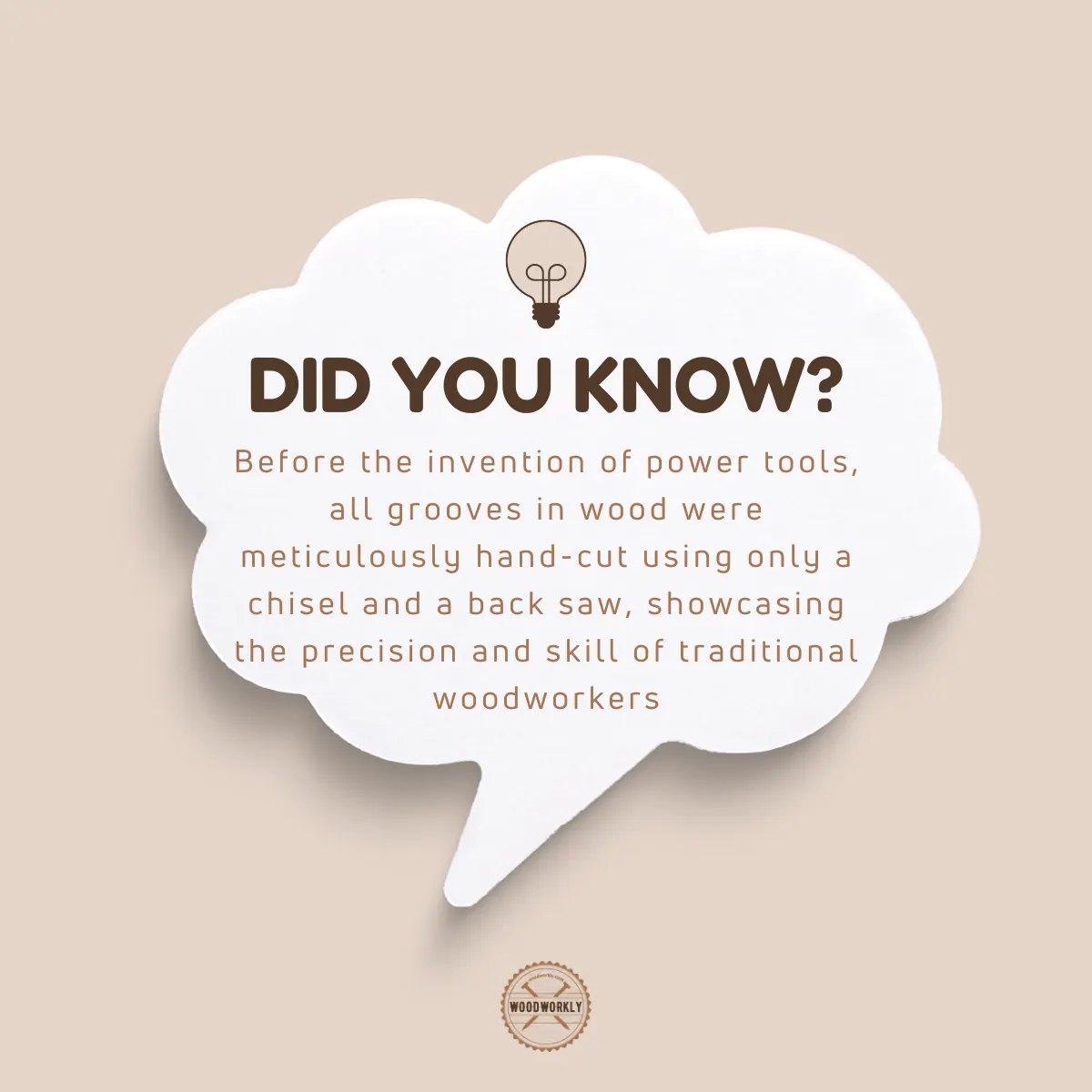
Understanding the Skill Required When Grooving By Hand
When cutting a groove by hand, you need to have enough practice and a steady hand.
If you’re a beginner in woodworking, you might not be able to get the groove perfect on your first try, and that’s perfectly ok.
I was the in the same position in my early days of woodworking. I have made lots of errors when grooving with hand tools. But I didn’t give up. I kept practicing until I become good at this.
It’s all about practice and patience as it is about skill and technique.
When you’re making a groove in wood by hand, make sure the lines are straight and evenly spaced.
When you’re making cuts with your backsaw, maintain a consistent depth all along the groove.
Make sure to keep the depth of the groove only around half of the thickness of the wood since cutting so deep can weaken the wood.
When you’re chiseling out the material within the groove, make sure the base is flat and smooth.
Those steps need attention to detail, and you need to master those skills.
Overall, as you can see cutting a groove by hand is totally possible. but it will take time and practice to master.
But once you do, you’ll have a skill that’s deeply satisfying and versatile.
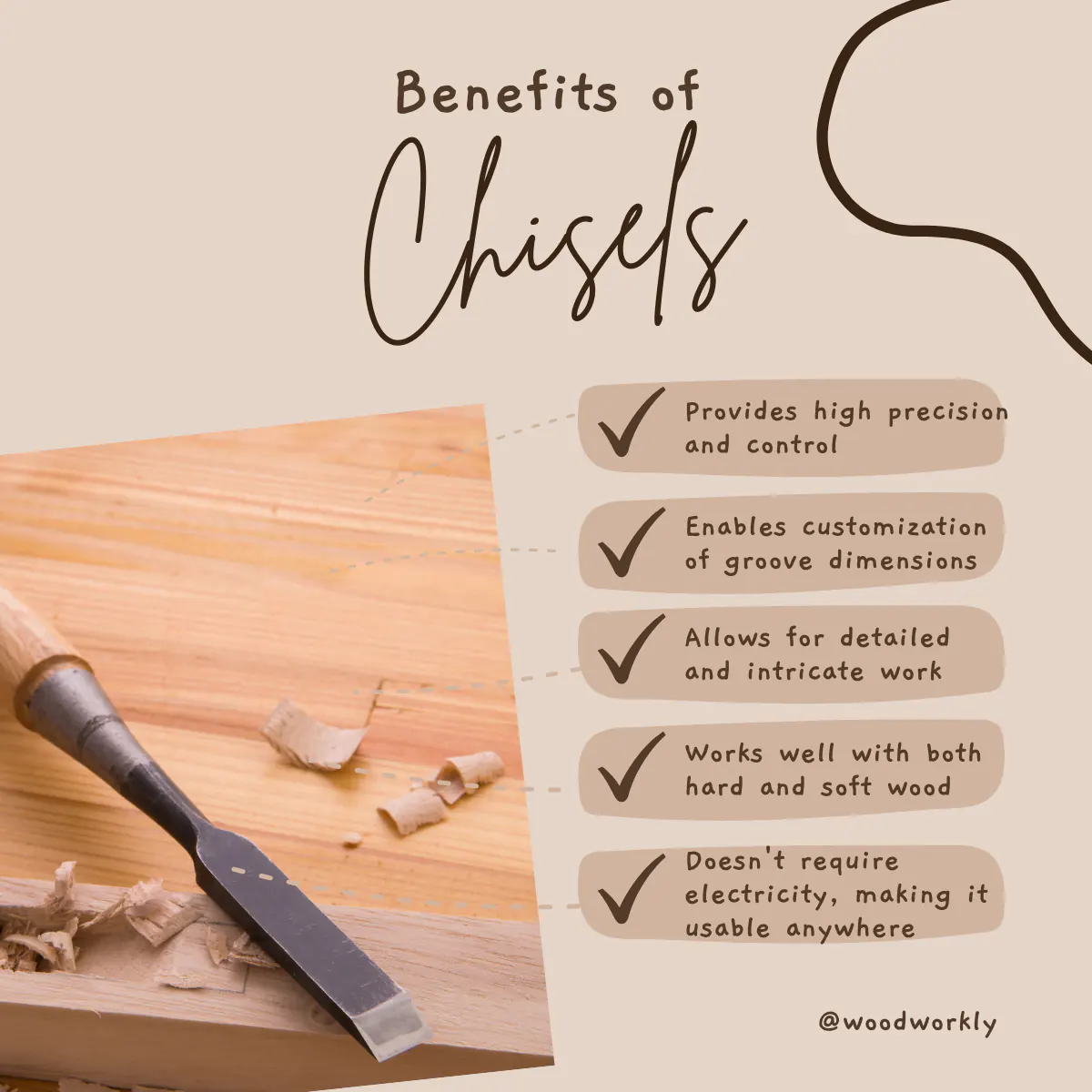
Before heading into the cutting procedure, there’re several factors you need to consider when cutting a groove by hand for optimal results.
Factors To Consider When Cutting a Groove in Wood by Hand
You need to have a clear plan and preparation when cutting the groove by hand. To do that there’re things you should consider first.
Here’re the things you need to consider when cutting a groove in wood by hand,
- Choose the right wood type.
- Determine the groove size.
- Safety considerations.
So, let’s talk about them in detail.
Choose the Right Type of Wood
Selecting the right type of wood is essential when cutting a groove in wood, especially by hand since it decides the technique you need to follow for groove cutting and the final look of the piece.
First, you need to have a good idea about the density of the wood you select like hardness or softness.
Hardwoods such as oak or maple come from deciduous trees. They have dense cellular fiber structures.
Hardwoods are sturdy and durable, but they are difficult to work with.
If you’re a beginner, I don’t recommend to start cutting a groove with hardwoods since they are not good for practicing since you’ll require more effort and sharper tools to cut them.
You’ll be frustrated very soon. But they will result in a durable piece that withstands for so long.
On the other hand, softwoods such as pine or cedar come from coniferous trees. They’re less dense and easy to cut and shape with hand tools.
Therefore, softwoods are great for beginners especially to learn carving skills to cut grooves in wood.
But softwoods won’t last for so long under heavy use.
Therefore, select the wood type that suits you the most when cutting grooves by hand. According to my recommendation, softwoods are good for you.
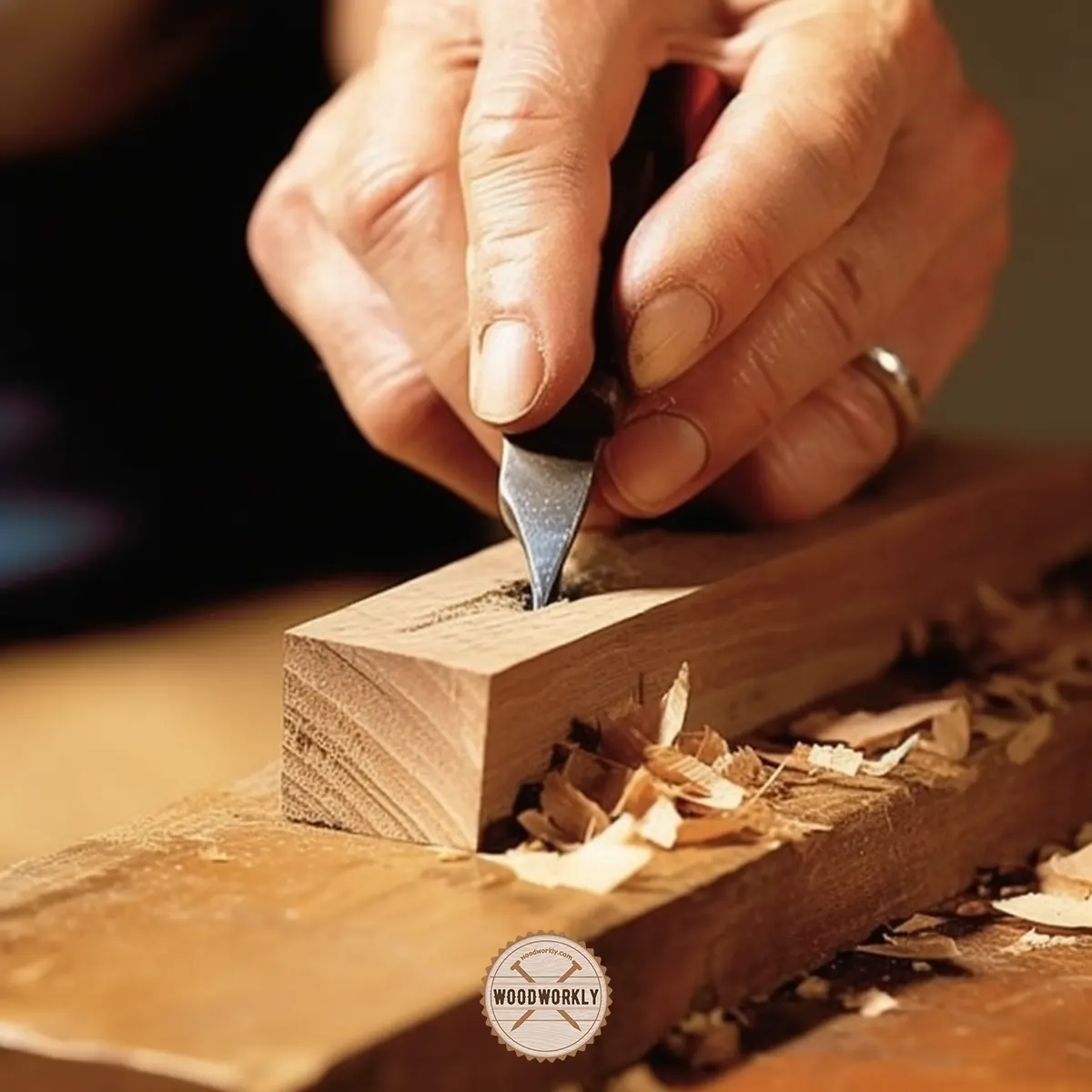
Determine Groove Size
After selecting the wood type, you need to decide the size of the groove you’re going to create.
Determining the groove size depends on your groove purpose and the design of the project.
When deciding the depth of the groove, make sure to cut it sufficiently to securely hold anything you’re planning to insert into it.
For example, If you’re making frame and panel construction, the groove you cut needs to be deep enough to hold the panel securely without popping out.
When deciding the width of the groove, make sure it is consistent with the thickness wood material you plan to insert.
It is always better to groove slightly wide than too narrow since you can always pare it down to get the perfect fit.
The position of the groove is also important to decide. Commonly centered grooves are mostly used but that totally depends on your project. You can go for multiple grooves as well if necessary.
By deciding the depth, width, and position of the groove you’re going to make at first, the cutting process will be so much easier for you.
Safety Considerations
As with any woodworking project, safety comes first.
The tools used for cutting grooves, particularly chisels, and saws, are sharp and can cause serious injury if mishandled.
Always wear protective gear, including safety glasses to protect your eyes from wood chips and dust, and durable gloves to protect your hands.
When handling your tools, make sure they are sharp and in good condition. Dull tools require more force to use, increasing the risk of slips and accidents.
Always cut away from yourself and keep your hands clear of the cutting line. When using a chisel, secure your wood piece firmly with clamps to prevent it from moving.
Remember, patience is key. Rushing can lead to mistakes or accidents.
Take your time, and make a beautifully hand-cut groove and all ten fingers intact!
Now let’s have a look at the most important thing you need to consider before groove cutting, selecting the right chisel for the project.
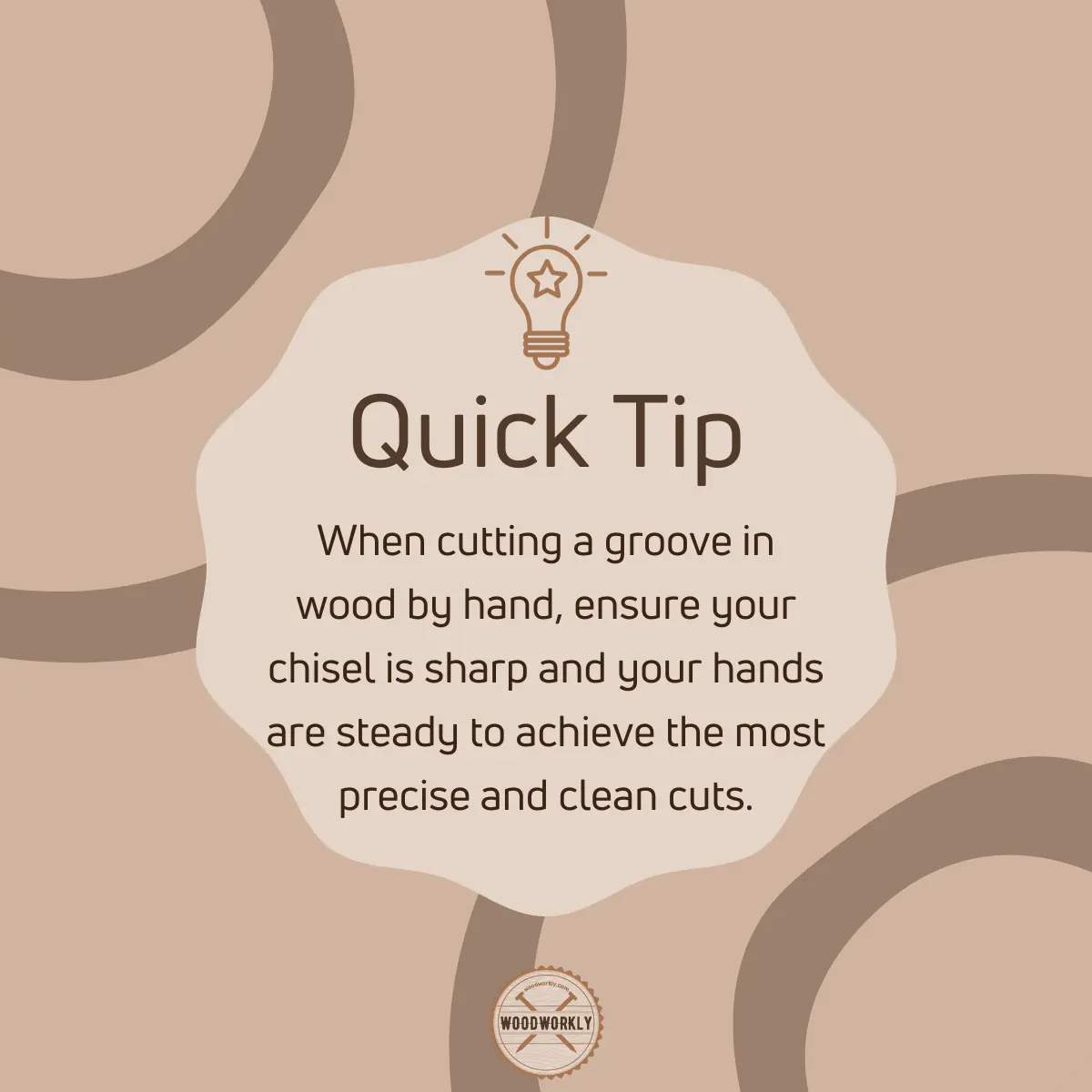
Suitable Chisel for Cutting Grooves in Wood
Selecting a suitable chisel is important to have to achieve precise and clean cuts when making a groove in the wood.
Not all the chisels work equally, some are good for making grooves while others don’t. therefore, you need to have good knowledge about their differences to select the right chisel for the groove-cutting process.
Different Types Of Chisels
Here’re the main chisel types use for woodworking projects,
- Bevel edge chisels
- Mortise chisels
- Paring chisels
Let’s have a look at the properties of each chisel type and select the one that suits you the most for grooving wood.
Bevel Edge Chisels
Bevel edge chisels are the most versatile chisel type that can use for many woodworking tasks.
Yes, you can use bevel-edge chisels for cutting a groove in the wood.
Bevel chisels have flattened sides leading to a beveled edge. This allows chisels to reach tight corners and perform detailed work.
Therefore, if you are willing to cut a groove in wood in a tight space, a bevel-edge chisel is an ideal tool to use.
Mortise Chisels
Mortise chisels are great for heavy-duty tasks like cutting mortises -deep, square holes.
Mortise chisels are great for carving out grooves in wood, especially in harder woods.
Pairing Chisels
Paring chisels are longer, thinner, and more flexible than other types of chisels. They are designed to gain more precise and detailed work and finishing touches.
Therefore, they are great for decorative purposes.
But pairing chisels are not suitable enough for cutting grooves in wood, but they are good for cleaning up the edges after the groove is cut.
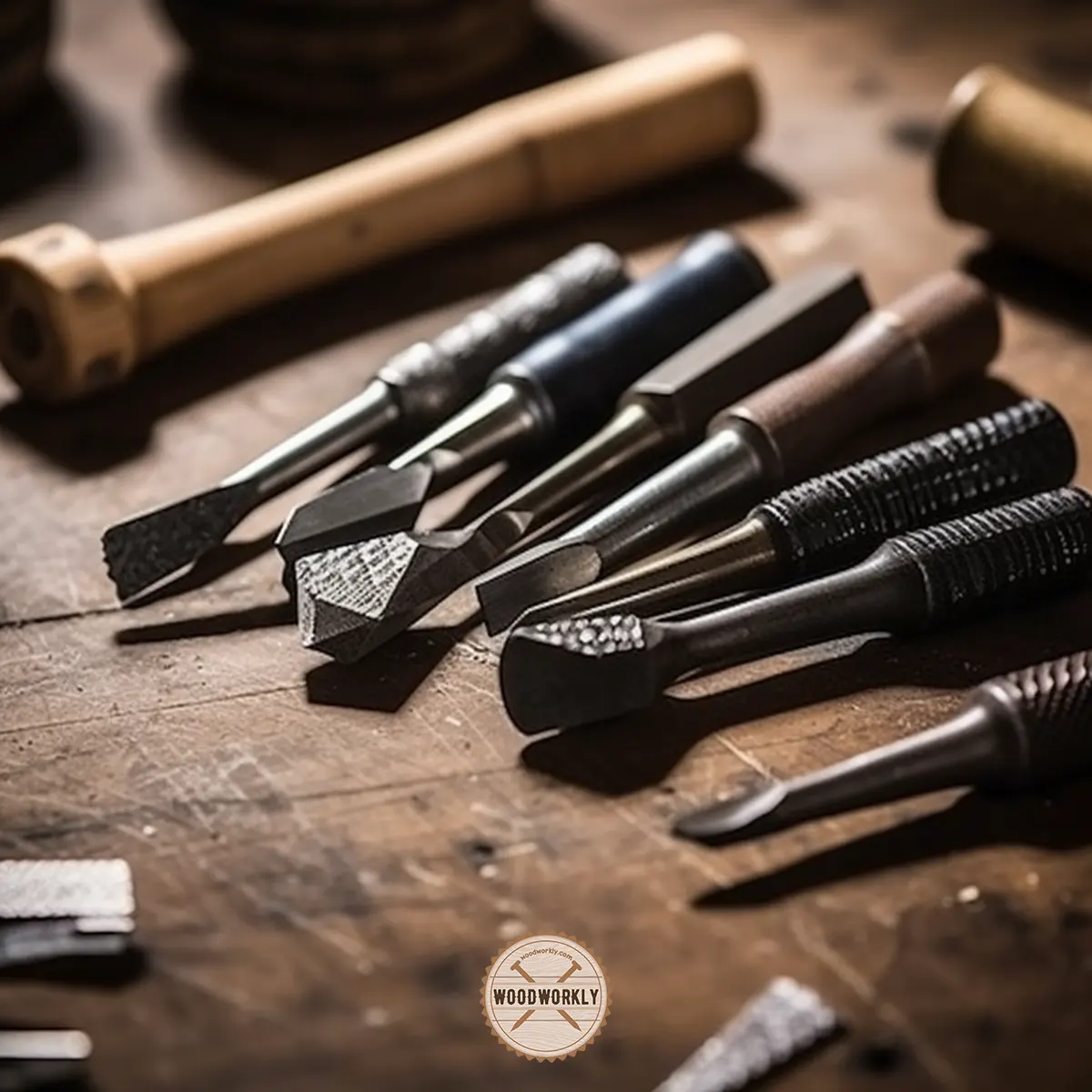
Choosing The Right Size of Chisel
After selecting the right type of chisel for your grooving project, you need to select the size that suits you the most according to the depth and width of the groove you’re going to cut.
Chisels come in different widths, typically ranging from ¼ inch to 2 inches.
For cutting grooves, select a chisel that’s as close to the width of the groove you’re about to cut.
This helps you to gain precise, clean, and consistent cuts.
Make sure not to select a chisel that’s too wide or too narrow since it can lead to overcutting and damage to the surrounding wood.
Quality and Maintenance Of Chisel
Select a quality, well-maintained chisel for cutting grooves to achieve precise and straight cuts avoiding tear-out.
Go for a chisel with a high-quality steel blade that will retain its edge and a conformable, sturdy handle.
Plus, check whether the chisel is well-maintained because even a quality chisel can go wrong if it’s not maintained well.
Sharp the chisel regularly to keep it clean and efficient. A dull chisel will give you rough cuts and cause injuries since you need more force to use it.
Because of those reasons, select the chisel from a quality brand and maintain it properly to create grooves that are both functional and aesthetically pleasing.
Ow, let’s head into our main project, the groove-cutting process by hand.
Stay focused till the end!
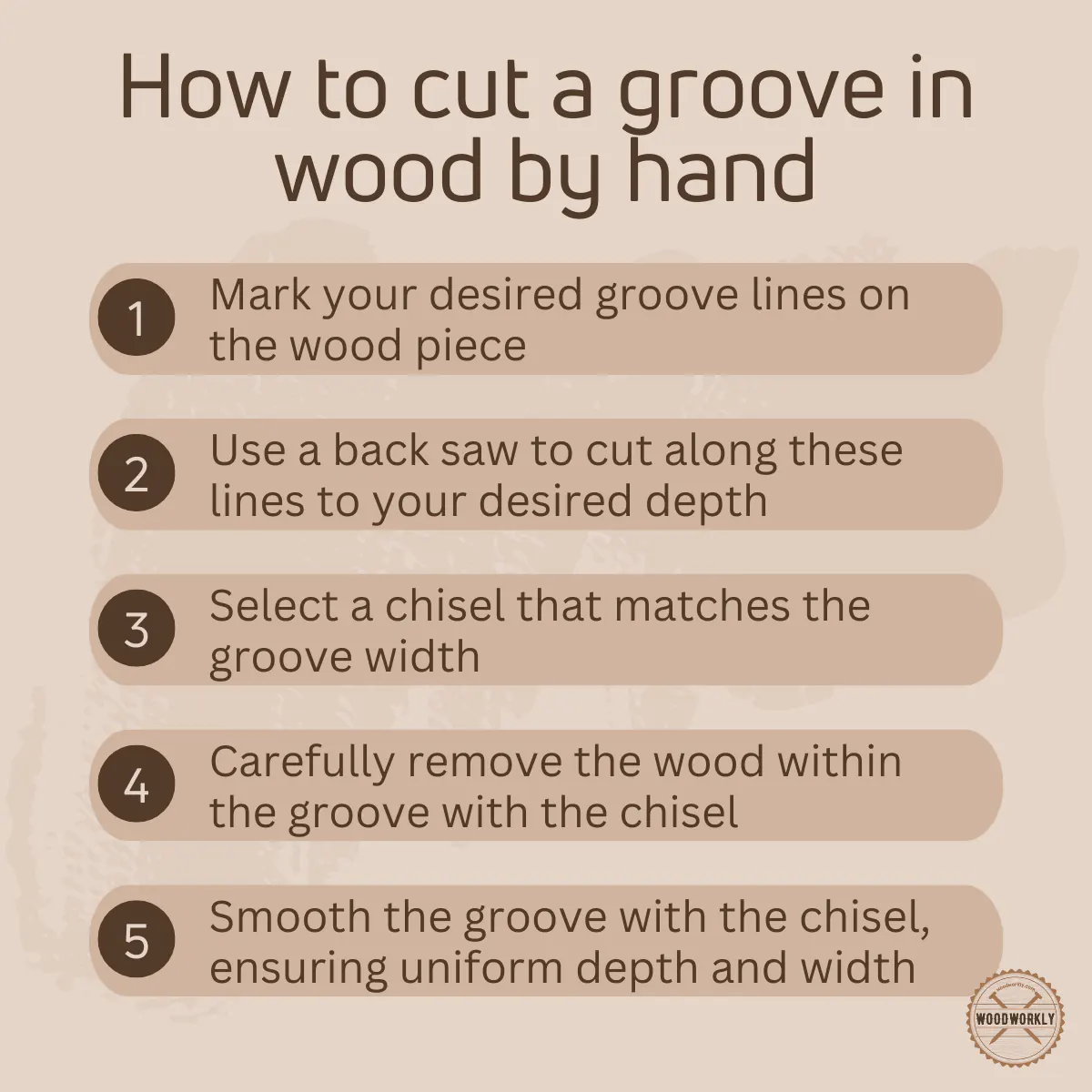
How To Cut a Groove in Wood by Hand?
Cutting a groove in wood by hand is easy when you follow the correct technique. It needs lots of patience, precision, and elbow grease.
Once you master the technique, you can make a detailed, precise cut when making grooves avoiding tear-out.
Here’re the steps you need to follow when cutting a groove by hand,
- Gather tools.
- Mark the groove depth and position.
- Cut the sides of the groove.
- Chisel out the groove.
- Clean and finish the groove.
- Inspect and refine the groove.
Let’s discuss each of the above steps in detail to cut a groove in wood by hand properly without making any mistakes.
1. Gather Tools
Before starting the groove-cutting process, gather the below tools at hand,
- A good quality chisel: Choose a chisel that’s as close as possible to the width of the groove you want to cut.
- Mallet or hammer: You’ll need this to drive the chisel into the wood.
- Back saw: This will help you mark out the groove.
- Square or ruler: This will help you measure and mark accurately.
- Pencil
- Fine grit sandpaper
2. Mark the Groove Depth and Position
First, you need to mark the start and the end points of the groove you’re going to cut.
Make sure to mark locations with high accuracy since if you made a mistake when marking the groove, that will affect the final result of the groove.
Use a ruler and square to mark the groove position. Draw two parallel lines with a pencil to represent the sides of the groove.
Make sure the lines you draw are straight and evenly spaced.
Consider the depth and the position of the groove when marking the lines.
The depth of the groove you cut should equal or be less than the thickness of the material to prevent the wood from weakening.
Groove depth should be sufficient to hold whatever you’re about to insert, but not so deep.
Position the groove in a spot that provides good functionality and look.
3. Cut the Sides Of The Groove
After marking the groove position with actual dimensions, use your back saw to cut along the lines you’ve drawn.
Cut down to the desired depth of your groove. Make sure to keep the saw straight and avoid cutting too deep.
4. Chisel Out the Groove
Now, place your chisel into the saw cut, bevel side up, and tap it gently with your mallet or hammer to start chiseling out the groove.
Be patient and take your time. After each tap, remove the chisel and clear away any wood chips.
Don’t rush the process since this is where you need to fully focus on the job. One mistake can result in a tear-out.
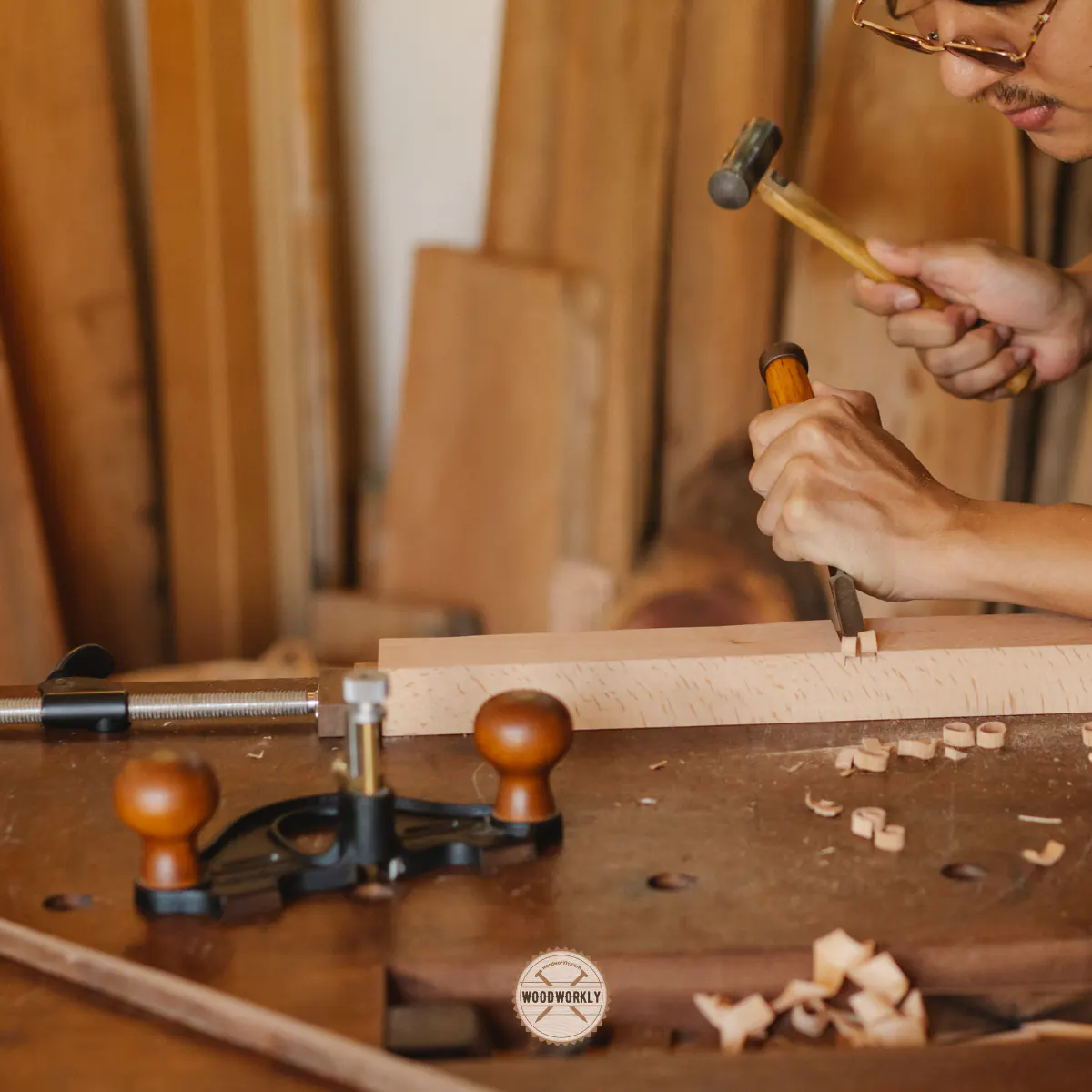
5. Clean and Finish the Groove
After cutting a groove in wood with a chisel, repeat the process with a wider or narrower chisel to clean up the edges and the bottom of the groove.
You can use a pairing chisel to do this since it’s great for a smooth and clean finish.
Pairing chisel removes the material within the groove and gives the groove a good, fine shape.
6. Inspect and Refine the Groove
Finally, inspect your work. If the groove isn’t as clean or as deep as you’d like, go back with your chisel and refine it.
Note that, it’s better to cut the groove too shallow initially and have to go back than to cut too deeply and damage the wood.
Congrats! Now you know how to cut a groove in wood by hand without using any power tool.
This is what ancient woodworkers mostly used and you can increase the precision of the job over time with practice.
Enjoy the process, learn from any mistakes, and take pride in your progress.
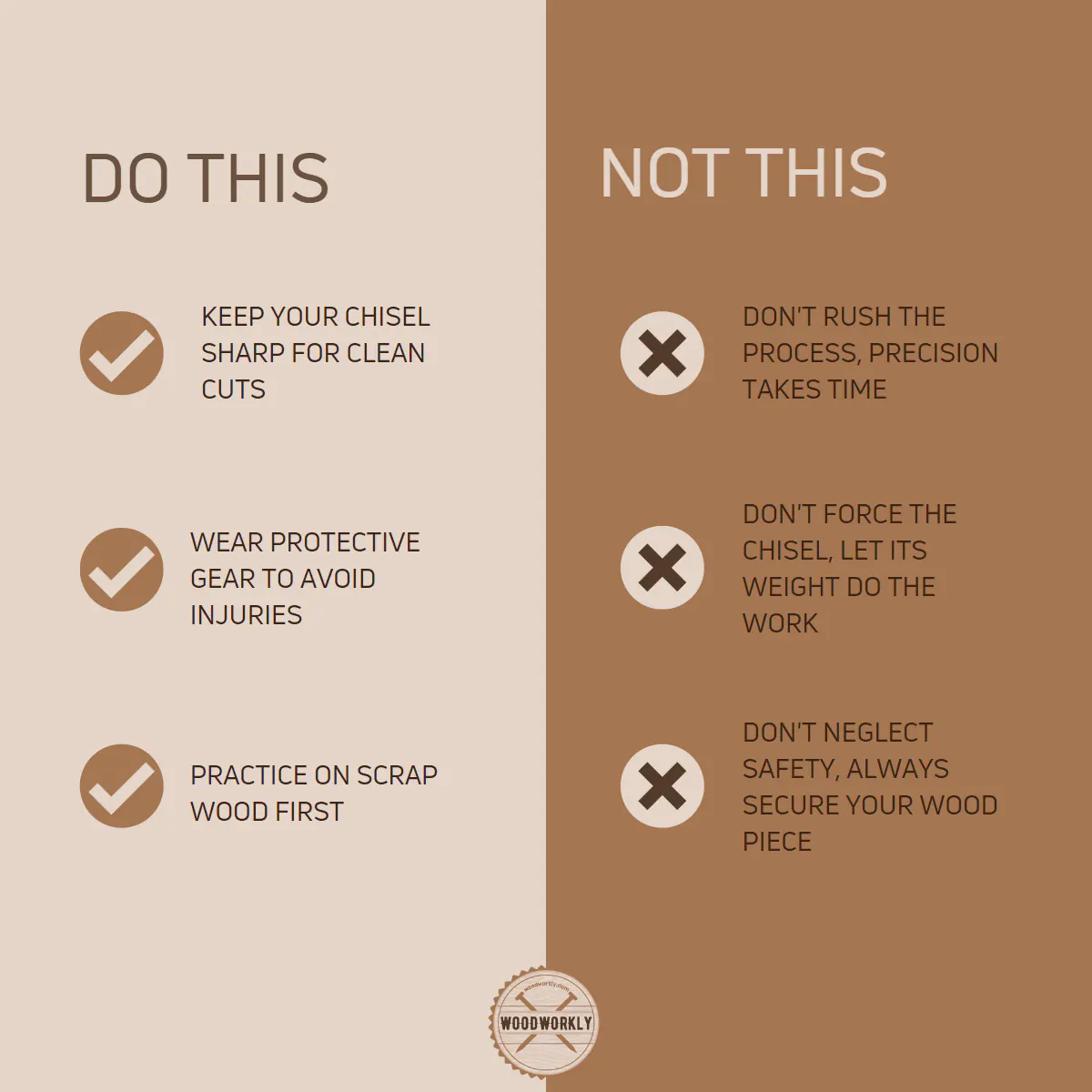
In order to make the process easier, and fun with minimal errors, I’ll tell you some tips.
I’ve learned those tips with years of working with chisels to cut grooves in different types of wood.
Tips To Cut A Groove in Wood by Hand
- Choose the wood wisely. Softwoods are more forgiving for beginners. They’re less dense, which makes them easier to cut and chisel. But grooves in hardwood are able to bear a high load and are more durable.
- Keep your saw and chisel sharp.
- Take your time, don’t rush the process.
- Practice on scrap wood first.
With all the above information, I know some of you’re fascinated and eagerly want to try cutting grooves in wood with this traditional method.
But some still prefer the modern and alternative methods to cut grooves in wood easily in a less amount of time.
For them, I’ve listed some alternative methods to cut grooves as well.
Alternative Methods to Cut a Groove in Wood
Here’re some alternative methods to cut grooves in wood,
- Using a router
- Using a table saw
- Using a circular saw
- Using a drill
- Using a Dremel
- Using a plow plane
Let’s see the features and functionalities of each of the above methods,
Using a Router
- You can use a router to cut various widths and depths and shapes of grooves with various wood.
- You can create different grooves by changing the router bit.
- You need to have a steady hand and patience to cut grooves with the router
In order to know more details, Read my latest comprehensive guide about cutting grooves in wood with a router.
Using a Table Saw
- A table saw is great for making straight cuts when making grooves.
- Settle the blade to the desired depth running along the fence to cut straight and clean grooves.
In order to know more details, Read my latest article about cutting grooves in wood with a table saw.
Using a Circular Saw
- A Circular saw is ideal for cutting grooves in large pieces of wood that can’t be cut with a table saw.
- The groove-cutting process is similar to the table saw method, setting the blade to the appropriate depth.
- Need steady hands and patience.
Read my latest article to know more about cutting grooves in wood with a circular saw.
Using a Drill
- Even though drill is not the most conventional method, it can be used to cut grooves.
- The drilling method involves drilling a series of holes along the path of the groove.
- Use a chisel to remove the remaining wood.
- Drilling is not the cleanest or fastest method, but it can be useful in certain situations.
Read my latest article about cutting grooves in wood with a drill.
Using a Dremel
- Dremel is great for cutting small and precise grooves.
- You can use different attachments with the Dremel to get desired groove size and shape.
In order to know more details, Read my latest article about cutting grooves in wood with a Dremel.
Using a Plow Plane
- A plow plane is a traditional woodworking tool that was specifically designed for cutting grooves.
- It’s a bit of a specialty tool and might not be in every woodworker’s toolbox, but it certainly gets the job done.
- It’s perfect for creating neat, clean grooves and allows for a lot of precision.
Each method has its pros and cons, and what works best will depend on the specifics of your project, your skill level, and the tools you have available.
That’s it, folks! Hope you learned everything you wanted to know about, how to cut a groove in wood by hand.

Let’s answer some frequently asked questions as well.
FAQs
Can you cut a groove in any type of wood?
Yes, you can cut a groove in any type of wood, but the hardness or softness of the wood will influence the difficulty of the task. Softer woods like pine or cedar are easier to work with for beginners, while hardwoods like oak or maple require more strength and control.
What tools do I need to cut a groove in wood by hand?
To cut a groove in wood by hand, the most essential tools are a sharp chisel and a mallet. A back saw can be useful for defining the edges of the groove, and a combination gauge can help ensure accuracy in your markings.
How deep should a groove be in wood?
The depth of your groove depends on the purpose of your project. However, a general guideline is to aim for a depth that is approximately half the thickness of your wood, ensuring the structural integrity of your piece remains intact.
How can I prevent my chisel from slipping when cutting a groove?
Keeping your chisel sharp is key to preventing slips, as a sharp chisel will cut through the wood more easily. Also, making small, controlled cuts, rather than large, forceful ones, can help maintain control and prevent the chisel from slipping.
Can I cut a groove in wood without a plow plane?
Yes, you can cut a groove in wood with a plow plane. Plow plane can make the process faster and more efficient, it’s entirely possible to cut a groove in wood by hand using a chisel and a mallet, as demonstrated in the step-by-step guide above.
Is there a way to practice cutting a groove before working on my actual project?
Yes, practicing on scrap wood is a great way to hone your skills before working on your final piece. This allows you to get a feel for your tools and technique without the worry of making a mistake on your project piece.
Is there any other method to cut a groove in wood without a chisel?
Yes, there are several alternative methods to cut a groove in the wood. One popular method is using a router or a table saw with a Dado blade, but these methods require additional tools and may not be suitable for beginners.
Did I cover all you wanted to know about How to Cut A Groove in Wood by Hand
In this article, I have deeply explained how to cut a groove in wood by hand with a step-by-step process. Plus, I’ve mentioned the way of selecting the right chisels for the project with all the tips and techniques.
To cut a groove in wood by hand, mark your desired groove lines on the wood. Use a back saw to cut along these lines to your desired depth. Then, with a chisel, carefully remove the wood within the groove, ensuring the chisel width matches the groove. Practice control to avoid overcutting.
Furthermore, I’ve answered some frequently asked questions as well.
Hope you learned everything you wanted to know about how to cut a Groove in wood by hand with proper technique.
Follow the given procedure carefully and practice each step well with scarp wood to be a pro at this game.